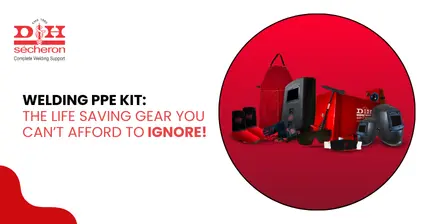What are Mild Steel Electrodes? A Detailed Explanation of Different Types with Examples
Introduction
In welding, choosing the right electrode is necessary to achieve a strong, reliable weld. Among these, mild steel electrodes play a pivotal role in welding applications due to their versatility and effectiveness. Let's delve into a comprehensive overview of ms welding electrodes, detailing their types, applications, and examples to help you understand their importance in welding processes.
What are Mild Steel Electrodes?
Mild steel electrodes are consumable welding rods (ms welding rods) used in shielded metal arc welding (SMAW) or stick welding. They are welding rods for mild steel or low-carbon steel. These electrodes facilitate the joining of mild steel components by melting and fusing with the base metal, forming strong and durable welds.
Types of Mild Steel Electrodes
1. E6013 Electrodes:
E6013 electrodes are versatile and easy to use, making them a popular option for general-purpose welding applications. They produce welds with smooth arc characteristics and good penetration.
Applications: Suitable welding rod for mild steels of thin to medium thickness in structures, frames, and automotive repairs.
2. E7018 Electrodes:
E7018 electrodes are known for their high tensile strength and low hydrogen content, making them ideal for welding high-strength steels and critical applications where weld integrity is crucial.
Applications: Used in structural welding, pipeline construction, heavy equipment assembly, and maintenance tasks requiring high-quality welds.
3. E6010 Electrodes:
E6010 electrodes offer deep penetration and are designed for welding in challenging positions, including overhead and vertical-down welding. They are often used for root passes in pipelines and structural welding.
Applications: Ideal for welding thick sections of mild steel and for applications where deep penetration is required.
4. E7014 Electrodes:
E7014 electrodes provide good deposition rates and are suitable for welding thicker sections of mild steel. They offer good slag removal and produce welds with moderate penetration.
Applications: Used in structural welding, assembling of heavy machinery, and general-purpose welding where higher deposition rates are required.
Examples of Mild Steel Electrode Applications
Construction and Fabrication: Mild steel electrodes are used widely in the construction of buildings, bridges, and other infrastructure projects.
Automotive Industry: They play a crucial role in the manufacturing and repair of vehicle frames, chassis, and structural components.
Industrial Maintenance: Mild steel electrodes are used for repairing machinery, equipment, and pipelines.
Choosing the Right Mild Steel Electrode
When selecting an ms welding electrode for your welding project, consider factors such as:
Thickness of the Base Metal: Choose electrodes that match the thickness of the metal being welded.
Welding Position: Different electrodes are designed for specific welding positions (e.g., flat, horizontal, vertical, overhead).
Welding Specifications: Match the electrode specifications with the welding requirements, including strength, penetration, and slag characteristics.
Conclusion
Understanding the types and applications of these electrodes helps ensure successful welding operations and durable weld joints. For high-quality mild steel electrodes and comprehensive welding solutions, consider D&H Sécheron.
11 May 2025 | Welding
An In-Depth Exploration of Low-Alloy Steel: Your Comprehensive Guide
11 May 2025 | Welding
Nagpur - Bori - Tuljapur Road MSH-3 in Yavatmal District (Maharashtra)
11 May 2025 | Welding
Guidelines to Understand Gas Welding: Applications, Advantages & Disadvantages
11 May 2025 | Welding
3 Tips for Finding the Best Mild Steel Electrode for Your Application
11 May 2025 | Welding
How to Select the Right Welding Filler Wires for Stainless Steel Welding?
11 May 2025 | Welding
Building the Narendra Modi Stadium with Norma V and Autotherme-1 Electrodes
11 May 2025 | Welding
Low Alloy Steel Welding in a (PEB) Pre Engineered Building Structure
11 May 2025 | Welding
Welding Rods: Different Types and Tips for Properly Storing and Handling
11 May 2025 | Welding
Tips for Flawless Welds with Stainless Steel Electrodes: Pros and Cons
11 May 2025 | Welding
Exploring Applications and Benefits of Stainless Steel Welding Electrodes
11 May 2025 | Welding
Welding Basics: Joining Metals with Heat and Pressure - A Beginners Guide
11 May 2025 | Welding
Distinguishing Low-Alloy Steel from High-Alloy Steel: Understanding the Variations
11 May 2025 | Welding
Hard Facing Wire - Understanding the Process and Achieving Optimal Result
11 May 2025 | Welding
Exploring the Advantages of Stainless Steel Electrodes in Welding Applications
11 May 2025 | Welding
Weathering Steel vs. Traditional Steel: A Comparative Analysis of Performance
11 May 2025 | Welding
Choosing the Right Welding Rod: Why 6013 Electrodes Might Be Your Ideal Option
11 May 2025 | Welding
Why 7018 Electrodes Are Preferred for High-Strength Welds in Pipeline Construction
11 May 2025 | Welding
Filler Wire vs. Stainless Steel Filler Wire: Understanding the Key Differences
11 May 2025 | Welding
Exploring the Impact of Filler Material on Welding Quality and Durability
11 May 2025 | Welding
Choosing the Right Cast Iron Electrode for Different Welding Projects
11 May 2025 | Welding
Top Advantages of Cast Iron Electrodes for Industrial Welding Applications
11 May 2025 | Welding
Key Benefits and Challenges of Using TIG Welding in Industrial Projects
11 May 2025 | Welding
5 Reasons Why 7018 Electrode is the Gold Standard for Welding Professionals
11 May 2025 | Welding
Top 5 Advantages of Flux Cored Arc Welding for Heavy-Duty Applications.png)
11 May 2025 | Welding
Lotherme-601: A Game-Changer for Restoring Shoulder Pins in Heavy Machinery
11 May 2025 | Welding
How D&H Sécheron Helped Repair a Rotary Kiln’s Cooler Section with LoTherme 352
11 May 2025 | Welding
Piston Repair for Mining Industry: Cost-Effective Solutions with LoTherme 468.webp)






.jpg)








































.jpg)
.jpg)

.jpg)

.jpg)





.jpg)
.jpg)
.jpg)



.webp)
.jpg)
.jpg)
.webp)
.jpg)





















.png)



.webp)

.webp)
.webp)



